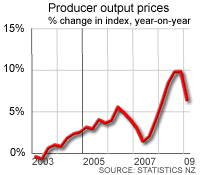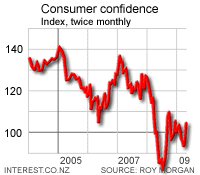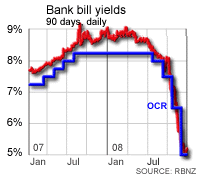 by BNZ Senior Markets Economist Craig Ebert As the formal growth forecasts – for both the international and NZ economies – continue to be trimmed, we wonder how much the recent drop in commodity prices might begin to stop the rot. To the extent this is the case (and we’ll be watching the upcoming sentiment surveys with this in mind), central banks should be wary of running policy too easy, even as the commodity reversal gives important relief on the headline CPI front. To be clear, though, we’re still talking about broader slowdowns at play (it’s just the degree and timing we’re wondering about). And an overall cooling remains undeniable in respect of New Zealand’s trading-partner outlook. August’s consensus growth forecasts of such, for 2008, for instance, lessened to 2.9%, from 3.0% in July’s survey. More significantly, the prognosis for 2009 was toned down even further – to 2.7%, from 2.8%. While not nearly as bad as we saw during the 1997/98 Asian, or even the post-equity crash period of 2000/01, it nonetheless portends an expansion in trading-partner GDP which is the slowest in at least six years. The broad view on the NZ economy also continues to get rated down. August’s consensus softened to 0.5% for calendar 2008 (from 0.8% in July, and 1.4% in June). And expectations for 2009 remained relatively low at 1.7%. Sure, these are no softer than we, and the RBNZ, already had. However, they do highlight a growing belief that the NZ economic slowdown is going to linger and not give way to the strong rebound we saw post the 1998 recession. And we can’t help but notice that the likes of the OECD leading indicator, and the share-market, suggest we might yet be sorely disappointed on NZ growth over the next six to twelve months.
by BNZ Senior Markets Economist Craig Ebert As the formal growth forecasts – for both the international and NZ economies – continue to be trimmed, we wonder how much the recent drop in commodity prices might begin to stop the rot. To the extent this is the case (and we’ll be watching the upcoming sentiment surveys with this in mind), central banks should be wary of running policy too easy, even as the commodity reversal gives important relief on the headline CPI front. To be clear, though, we’re still talking about broader slowdowns at play (it’s just the degree and timing we’re wondering about). And an overall cooling remains undeniable in respect of New Zealand’s trading-partner outlook. August’s consensus growth forecasts of such, for 2008, for instance, lessened to 2.9%, from 3.0% in July’s survey. More significantly, the prognosis for 2009 was toned down even further – to 2.7%, from 2.8%. While not nearly as bad as we saw during the 1997/98 Asian, or even the post-equity crash period of 2000/01, it nonetheless portends an expansion in trading-partner GDP which is the slowest in at least six years. The broad view on the NZ economy also continues to get rated down. August’s consensus softened to 0.5% for calendar 2008 (from 0.8% in July, and 1.4% in June). And expectations for 2009 remained relatively low at 1.7%. Sure, these are no softer than we, and the RBNZ, already had. However, they do highlight a growing belief that the NZ economic slowdown is going to linger and not give way to the strong rebound we saw post the 1998 recession. And we can’t help but notice that the likes of the OECD leading indicator, and the share-market, suggest we might yet be sorely disappointed on NZ growth over the next six to twelve months.  For their part, tomorrow’s producer price data will most probably highlight the intense profit squeeze besetting the wider economy (with ramifications for the jobs market), as cost pressures outpace the extent to which businesses are willing and able to hike prices, amid stalling demand. In keeping with this, the market is looking for a 2.6% increase in the Q2 producer output price index, for 8.8% y/y, with a 2.1% increase in input prices, for an annual 7.3%. Yes, a lot of this will reflect the commodity price shocks of the quarter (especially oil), with spiking electricity generation and supply prices also a continued headache. However, that won’t be to deny still-strong price pressures at heart – a reminder of the need for the economy to keep cooling down. That GDP probably slipped a bit further during the June quarter remains our view. This will be tested, however, by Thursday’s NBNZ Regional Trends survey. While just a rudimentary indicator of activity across the various regions, it has a habit of picking the broad ups and downs of overall GDP relatively well. As for the hard indicators, the 1.5% drop in Q2 real retail activity reported last Friday will go a long way to keeping GDP for the quarter on the back foot. And while the retail weakness was accentuated by a big drop in car buying, it nonetheless confirmed the softest run in spending since the early 1990s recession. And we suspect that trend was not bucked in July, with Thursday’s spending indicators likely to maintain their recent underlying weakness. The way we look at it, any failure of the Electronic Card Transactions and credit card billings to bounce back from recent declines – as seems the risk – would simply underscore the extent of retail angst, with the degree of discounting outweighing the extent of sales volume growth in spurs. Either way, it’s still a sign of an adjustment toward to a more sustainable, and generally softer, level of consumer demand. This will be reinforced by a more obvious easing in the labour market than we’ve seen over the first half of 2008, the housing market remaining on the back foot, relatively tight credit markets and a continued imperative of households to get their spending better aligned with incomes. Having said this, we also wonder if consumers, as they battle on, might soon be overcoming the worst of their shellshock. The personal tax cuts, of 1 October, are coming closer into view, for example. And we’ve seen about half that amount effectively stuffed in households’ pockets already, given the retreat in petrol prices over recent weeks.
For their part, tomorrow’s producer price data will most probably highlight the intense profit squeeze besetting the wider economy (with ramifications for the jobs market), as cost pressures outpace the extent to which businesses are willing and able to hike prices, amid stalling demand. In keeping with this, the market is looking for a 2.6% increase in the Q2 producer output price index, for 8.8% y/y, with a 2.1% increase in input prices, for an annual 7.3%. Yes, a lot of this will reflect the commodity price shocks of the quarter (especially oil), with spiking electricity generation and supply prices also a continued headache. However, that won’t be to deny still-strong price pressures at heart – a reminder of the need for the economy to keep cooling down. That GDP probably slipped a bit further during the June quarter remains our view. This will be tested, however, by Thursday’s NBNZ Regional Trends survey. While just a rudimentary indicator of activity across the various regions, it has a habit of picking the broad ups and downs of overall GDP relatively well. As for the hard indicators, the 1.5% drop in Q2 real retail activity reported last Friday will go a long way to keeping GDP for the quarter on the back foot. And while the retail weakness was accentuated by a big drop in car buying, it nonetheless confirmed the softest run in spending since the early 1990s recession. And we suspect that trend was not bucked in July, with Thursday’s spending indicators likely to maintain their recent underlying weakness. The way we look at it, any failure of the Electronic Card Transactions and credit card billings to bounce back from recent declines – as seems the risk – would simply underscore the extent of retail angst, with the degree of discounting outweighing the extent of sales volume growth in spurs. Either way, it’s still a sign of an adjustment toward to a more sustainable, and generally softer, level of consumer demand. This will be reinforced by a more obvious easing in the labour market than we’ve seen over the first half of 2008, the housing market remaining on the back foot, relatively tight credit markets and a continued imperative of households to get their spending better aligned with incomes. Having said this, we also wonder if consumers, as they battle on, might soon be overcoming the worst of their shellshock. The personal tax cuts, of 1 October, are coming closer into view, for example. And we’ve seen about half that amount effectively stuffed in households’ pockets already, given the retreat in petrol prices over recent weeks.  Perhaps this is why the Roy Morgan poll of consumer confidence recovered to 94.9 in its mid-August survey – a 7.1 point jump from early August, to its best reading since mid April (100.0). Sure, these are still results substantially below par. But the continued rebound is worth noting nevertheless. Speaking of which, an area we’re starting to monitor very intently is the primary sector. It might yet be the most important to New Zealand’s economic profile over the foreseeable future. Understandably, it’s been an area downgraded by most analysts and commentators since late last year – sullied by the early-2008 drought, in particular, and blotted out more generally by the year-long, high-profile, travails in the housing, retailing and finance sectors and, more recently, by the gloom pervading the broader business sector. However, it bears noting that New Zealand’s commodity export prices remain, by and large, relatively high, and, with their preponderance in (protein) food products, are, so far at least, bucking the recent correction in global commodity prices. Couple this with a falling exchange rate and we’re talking about a growing backstop of income for an otherwise struggling economy. Sure, costs are hammering farmers as much as they are any other business at the moment (something we expect to see in tomorrow’s PPI data). But even in this respect there seems more likelihood of relief than further restraint, especially to the extent fuel, feed and fertilizer costs come off their recent spikes. Watch that space.
Perhaps this is why the Roy Morgan poll of consumer confidence recovered to 94.9 in its mid-August survey – a 7.1 point jump from early August, to its best reading since mid April (100.0). Sure, these are still results substantially below par. But the continued rebound is worth noting nevertheless. Speaking of which, an area we’re starting to monitor very intently is the primary sector. It might yet be the most important to New Zealand’s economic profile over the foreseeable future. Understandably, it’s been an area downgraded by most analysts and commentators since late last year – sullied by the early-2008 drought, in particular, and blotted out more generally by the year-long, high-profile, travails in the housing, retailing and finance sectors and, more recently, by the gloom pervading the broader business sector. However, it bears noting that New Zealand’s commodity export prices remain, by and large, relatively high, and, with their preponderance in (protein) food products, are, so far at least, bucking the recent correction in global commodity prices. Couple this with a falling exchange rate and we’re talking about a growing backstop of income for an otherwise struggling economy. Sure, costs are hammering farmers as much as they are any other business at the moment (something we expect to see in tomorrow’s PPI data). But even in this respect there seems more likelihood of relief than further restraint, especially to the extent fuel, feed and fertilizer costs come off their recent spikes. Watch that space.  With all of this, we continue to argue against any aggressive easing by the RBNZ. To be sure, we still believe the Bank should keep trimming the OCR by 25bps at each of the next many meetings (simply to meet current market expectations, else interest rates will certainly jump). And we still like the 6.00% anchor we have for mid next year and 5.50% by end-2009. However, for the near term, the balance of risk would be for the Bank taking a mid-cycle pause rather than front-running with a 50 point cut over coming months. * This economic preview was written by BNZ's Senior Markets Economist Craig Ebert. A full version of this report with charts can be found here. All of the research from the BNZ Markets team of economists is available here.
With all of this, we continue to argue against any aggressive easing by the RBNZ. To be sure, we still believe the Bank should keep trimming the OCR by 25bps at each of the next many meetings (simply to meet current market expectations, else interest rates will certainly jump). And we still like the 6.00% anchor we have for mid next year and 5.50% by end-2009. However, for the near term, the balance of risk would be for the Bank taking a mid-cycle pause rather than front-running with a 50 point cut over coming months. * This economic preview was written by BNZ's Senior Markets Economist Craig Ebert. A full version of this report with charts can be found here. All of the research from the BNZ Markets team of economists is available here.
Opinion: Why the RBNZ shouldn't cut too aggressively
Opinion: Why the RBNZ shouldn't cut too aggressively
18th Aug 08, 4:17pm
by
We welcome your comments below. If you are not already registered, please register to comment
Remember we welcome robust, respectful and insightful debate. We don't welcome abusive or defamatory comments and will de-register those repeatedly making such comments. Our current comment policy is here.